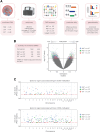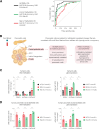DNA Methylation Biomarkers Predict Offspring Metabolic Risk From Mothers With Hyperglycemia in Pregnancy
- PMID: 40834241
- PMCID: PMC12365412
- DOI: 10.2337/db25-0105
DNA Methylation Biomarkers Predict Offspring Metabolic Risk From Mothers With Hyperglycemia in Pregnancy
Abstract
Maternal hyperglycemia is linked to 19 cord blood DNA methylation biomarkers that predict offspring metabolic dysfunction. These methylation changes, associated with maternal glycemic status, improved the prediction of β-cell dysfunction at 7, 11, and 18 years of age compared with clinical factors alone. Validation in human β-cells and pancreatic ductal epithelial cells confirmed that hyperglycemia influences methylation-dependent gene expression. These findings highlight the role of epigenetic modifications at birth as early indicators of diabetes risk, suggesting that in utero hyperglycemic exposure may mediate long-term metabolic outcomes in offspring.
© 2025 by the American Diabetes Association.
Conflict of interest statement
Figures



References
-
- Sweeting A, Hannah W, Backman H, et al. Epidemiology and management of gestational diabetes. Lancet 2024;404:175–192 - PubMed
-
- Magliano DJ, Boyko EJ; IDF Diabetes Atlas 10th Edition Scientific Committee 2021 . IDF Diabetes Atlas. 10th ed. Brussels: International Diabetes Federation, 2021
-
- Arora GP, Åkerlund M, Brøns C, et al. Phenotypic and genotypic differences between Indian and Scandinavian women with gestational diabetes mellitus. J Intern Med 2019;286:192–206 - PubMed
MeSH terms
Substances
Grants and funding
LinkOut - more resources
Full Text Sources
Medical

